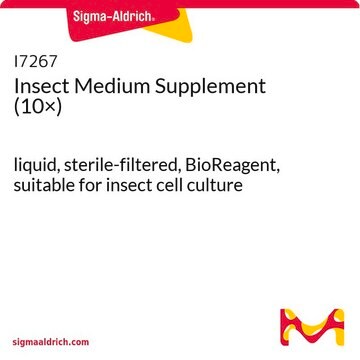S3652
Shields and Sang M3 Insect Medium
With ʟ-glutamine and potassium bicarbonate, liquid, sterile-filtered, suitable for insect cell culture
Synonym(s):
Insect Medium, M3 Insect Medium, Sang Insect Medium
Sign Into View Organizational & Contract Pricing
All Photos(1)
About This Item
Recommended Products
Product Name
Shields and Sang M3 Insect Medium, With L-glutamine and potassium bicarbonate., liquid, sterile-filtered, suitable for insect cell culture
Quality Level
sterility
sterile-filtered
form
liquid
technique(s)
cell culture | insect: suitable
components
glucose: 10 g/L (Dextro)
L-glutamine: 0.6 g/L
shipped in
ambient
Storage temp.
2-8°C
Looking for similar products? Visit Product Comparison Guide
Application
Developed for the culture of Drosophila cell lines.
Shields and Sang M3 Insect Medium has been used to culture Drosophila cell lines, larvae, and testes.
Biochem/physiol Actions
Insect tissue culture media have been formulated to mimic the main properties of the hemolymph of specific insects. A survey of the formulas of these media reveals significant differences in their composition. When supplemented with 5-20% heat-inactivated fetal bovine serum, Shields and Sang M3 medium has been found to support the rapid growth of both primary and established cultures of Drosophila melanogaster cells.
also commonly purchased with this product
Product No.
Description
Pricing
Storage Class
12 - Non Combustible Liquids
wgk_germany
WGK 3
flash_point_f
Not applicable
flash_point_c
Not applicable
Choose from one of the most recent versions:
Already Own This Product?
Find documentation for the products that you have recently purchased in the Document Library.
Customers Also Viewed
Rosalind Hale et al.
eLife, 4 (2015-02-25)
To understand how long-range patterning gradients are interpreted at the cellular level, we investigate how a gradient of expression of the Four-jointed kinase specifies planar polarised distributions of the cadherins Fat and Dachsous in the Drosophila wing. We use computational
Remigio Picone et al.
PLoS biology, 8(11), e1000542-e1000542 (2010-11-26)
Because physical form and function are intimately linked, mechanisms that maintain cell shape and size within strict limits are likely to be important for a wide variety of biological processes. However, while intrinsic controls have been found to contribute to
Shuhei Kimura
FEBS letters, 587(7), 922-929 (2013-03-05)
Spermiogenesis is a dynamic process leading to alterations in cell morphology. In spermiogenesis, the roles of the histone chaperones are largely unknown. Here, I report the unexpected roles of two Nap family proteins, CG5017/Hanabi and nucleosome assembly protein 1 (Nap1)
Giri Raj Dahal et al.
Development (Cambridge, England), 144(15), 2771-2783 (2017-07-08)
Loss of embryonic ion channel function leads to morphological defects, but the underlying reason for these defects remains elusive. Here, we show that inwardly rectifying potassium (Irk) channels regulate release of the
Arthur Luhur et al.
G3 (Bethesda, Md.), 10(12), 4541-4551 (2020-10-09)
Successful Drosophila cell culture relies on media containing xenogenic components such as fetal bovine serum to support continuous cell proliferation. Here, we report a serum-free culture condition that supports the growth and proliferation of Drosophila S2R+ and Kc167 cell lines.
Our team of scientists has experience in all areas of research including Life Science, Material Science, Chemical Synthesis, Chromatography, Analytical and many others.
Contact Technical Service







